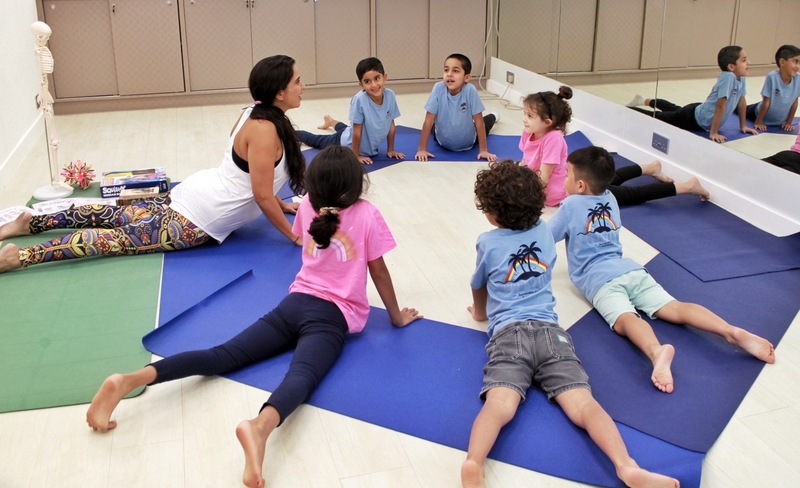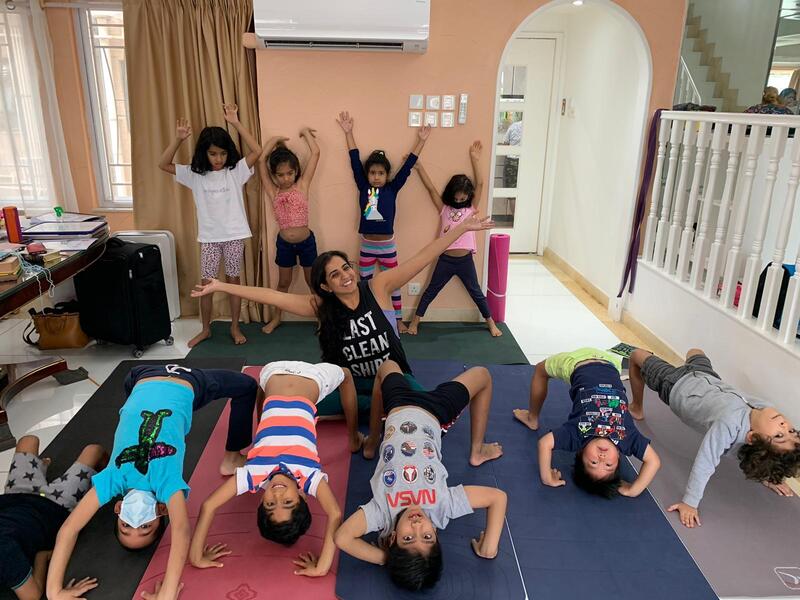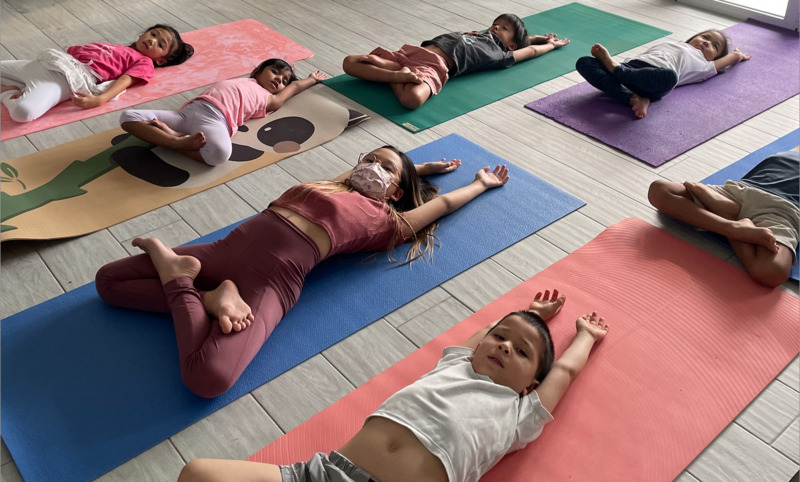Why isn’t Kids’ Yoga More Common?
by Menka Purswaney Amin
Yoga, as any experienced instructor knows, comprises numerous layers and nuances. Yoga is as vast and profound as an ocean. This comprehension significantly influences how and what we teach children.
In the realm of yoga, we all learn differently and are drawn to diverse aspects. Hence, there’s something within yoga for everyone—every body and every child. So, what’s in it for children?

For children who are more physical or restless, yoga offers a multitude of poses: standing, backbends, forward bends, sitting, supine poses, arm balances, and even inversions. If age-appropriate and taught safely, I couldn’t recommend inversions more. Children naturally excel at them, and they are immensely advantageous. I often witness children, including my own, somersaulting on a pile of bolsters into Halasana without any fear at all. Many times I find their feet on the wall and hands on the floor. This elicits joy, and it’s unsurprising; elevating the heart above the head oxygenates the brain, leaving them refreshed and invigorated.
For children who are inclined towards logic and nonfiction, yoga constitutes science and anatomy. We delve into the eleven systems of the body and their functioning. Visual aids, props, and arts and crafts serve as invaluable tools for this purpose. We needn’t be artists, but art facilitates the understanding of curious minds about the body beneath the skin. For instance, children study the components of a spine on the same day when we stand tall as resolute warriors with impeccable posture. Crafting a spine aids in that “aha” moment when they stand erect.
For children who struggle physically, perhaps due to knock knees or pronated feet, yoga imparts a sense of body alignment and weight distribution, tending to their feet, ankles, knees, muscles, hips, back, shoulders, neck, head, and eyes.
For children who possess inherent empathy and compassion, yoga revolves around self-awareness and comprehending one’s emotions, which extends to understanding the feelings of others. The better we fathom ourselves, the clearer our perception of the world becomes; improved communication leads to better understanding and connections with others. Emotional intelligence originates from within and fosters trust, friendships, and community.
For children inclined towards spirituality, pondering life’s purpose, yoga explores realms beyond us, something that exists even when we cannot fully articulate it. It’s present, and we can tap into it, experiencing abundance.

For children grappling with self-esteem issues, seeking validation, being exceedingly shy, disruptive, or harboring a fear of making mistakes, yoga instills self-acceptance, self-love, and self-belief. Yoga also provides guidance on how to navigate our bodies, which in turn translates to navigating our minds and lives.
For children overwhelmed by schoolwork, social media, or exposed to anxiety, stress, and fear at home, yoga teaches detachment from these emotions. Yoga teaches them to observe these feelings from a distance, devoid of judgment. They learn to empty themselves, becoming a clean slate, and then select an emotion for the day, week, or month.
For children experiencing grief, yoga imparts the understanding that relationships hold meaning. Each relationship imparts a lesson; it’s not a loss or a failure but an opportunity for learning.
And now, my particular concern. Within the teaching realm, many instructors and adults underestimate children’s capacity to comprehend the broad and subtle, the concrete and the abstract. This perplexes me because children’s minds are most absorbent and agile during their early years. Numerous scientists, including Dr. Maria Montessori, have discussed the absorbent mind during early childhood. Just like adults, children thrive on interaction. They revel in connecting, playing, creating, contributing, and assisting. These activities release hormones like endorphins, oxytocin, and dopamine. Kids’ yoga encompasses all these elements.
As instructors, our role is not to inundate them with facts but to sow seeds that will sprout at their own pace, allowing them to delve deeper. We don’t dictate their thoughts; we empower them to think independently, enabling them to make sound decisions. Whether it’s choosing words, actions, friends, or food, they can opt for faith, devotion, inquiry, and decipher peer pressure for what it is. They learn that making mistakes is permissible, and getting back up is essential.
There can be no comfort without discipline… Only disciplined action takes you to freedom.
BKS Iyengar
Self-regulation is a challenge for children (and even many adults). Mr. Iyengar observed, “Only disciplined action leads to freedom.” By making sound choices, we attain freedom. If I had the freedom to consume 50 chocolates in a day, yes, I’d be free as there’s no restraint. However, later, I’d feel unwell, limiting my freedom to engage in other activities I cherish with loved ones. This concept might appear intricate for teaching children. Nonetheless, they are blank canvases, less conditioned, and often grasp concepts better than us. Guiding kids necessitates an understanding of the best methods to connect with them. By utilizing swift dynamic poses, tranquil moments, songs, stories, games, and props, alongside a structured yet not rigid lesson plan, I’ve discovered that I can infuse a topic often deemed serious with an element of enjoyment. Stories wield the power to heal and transform, and yogis perceive stories, gratitude, and lessons within every experience. We employ songs to remember the colours of the rainbow or the tale of the boy who cried wolf to comprehend satya (truth/honesty), don’t we? Songs can aid children in learning the meanings of Sanskrit words related to yoga.
As an instructor, I’ve noted that introducing some Sanskrit or yogic mantras to children at an early age confers a distinct advantage. Sanskrit is the language of yoga. There’s a certain age when acquiring languages is simpler than during adulthood. Consequently, learning the Sanskrit names for poses, mantras, yamas, niyamas, and the eight limbs at a young age is feasible. Expressing the same concepts in English falls short. Doesn’t “bread” and “croissant” evoke different feelings, even though they’re made from the same ingredients? One is English, and the other is French.
In my class parents receive summaries of each class, providing a starting point for conversations with their children. “I heard you learned about ‘calm breath, calm mind, shaky breath, shaky mind.’ Are you breathing through your nose today?”

More than ever, parents recognize that yoga is one of the best gifts they can bestow upon their child. Starting early preempts numerous struggles, not only on a physical plane but mentally as well. When envisioning the qualities we desire for our children, do we contemplate courage, strength, resilience, self-love, self-acceptance, gratitude, dexterity, compassion, connection, and confidence? Do we wish for them to discern when to be assertive and when to be gentle? Undoubtedly, yoga is an exceptional gift!

